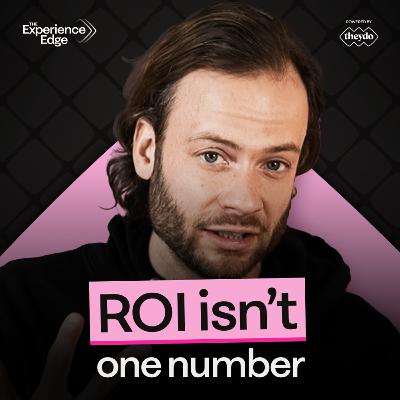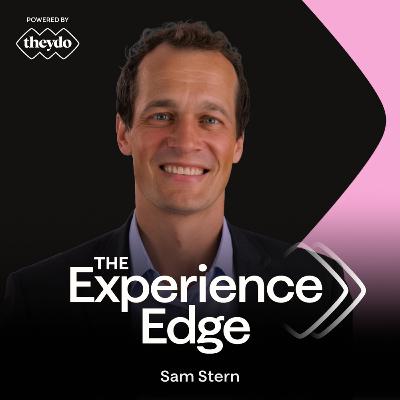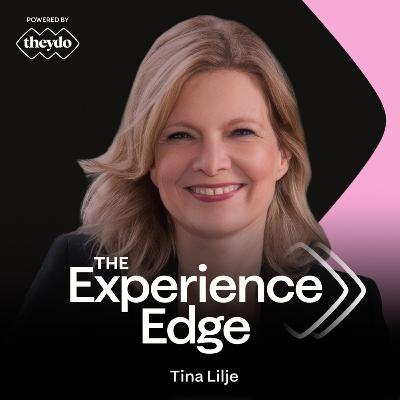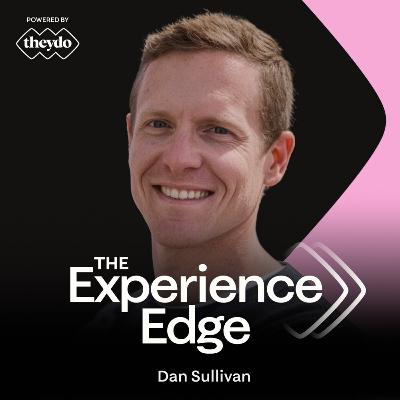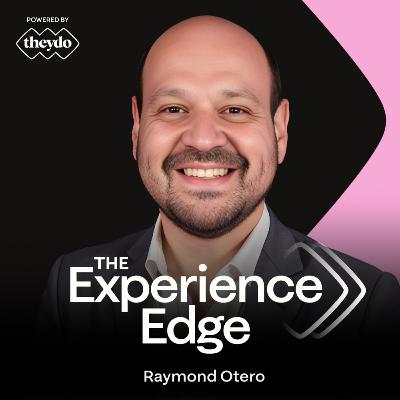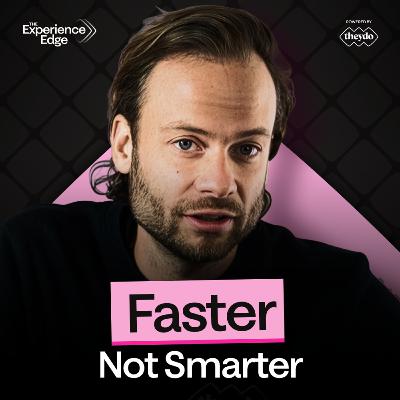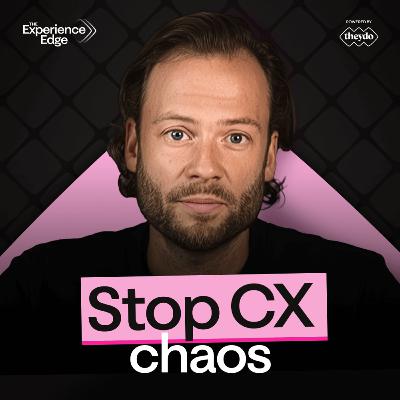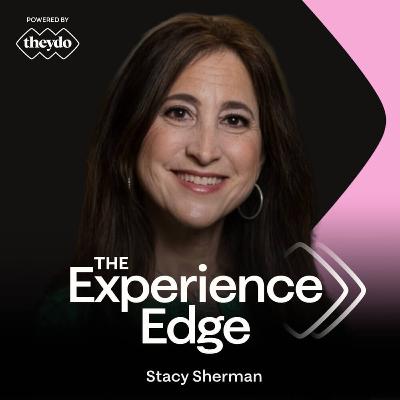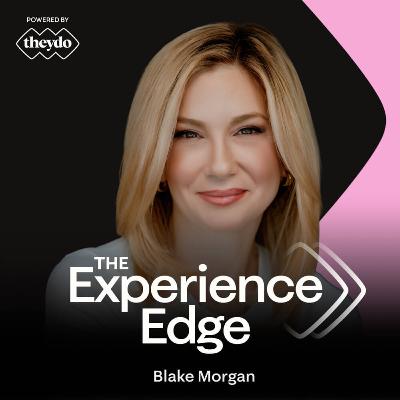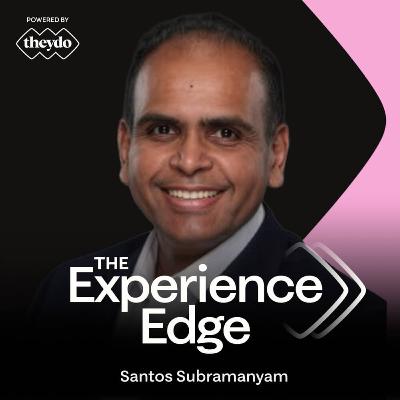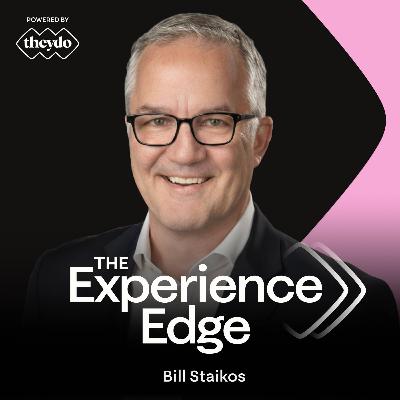Discover The Experience Edge
The Experience Edge

The Experience Edge
Author: Jochem van der Veer
Subscribed: 1Played: 0Subscribe
Share
© Jochem van der Veer
Description
Hosted by Jochem van der Veer, customer-obsessed founder of TheyDo, this weekly podcast dives into conversations with senior professionals, pioneers, and industry leaders at the forefront of CX. Guests openly share their experiences on customer journeys, voice of the customer, customer-centric transformation, journey management, and best practices for lasting impact.
63 Episodes
Reverse
Most CX teams struggle to show ROI because they’re looking in the wrong place. CX isn’t just one metric and it was never meant to be. As Jochem van der Veer explains, leaders don’t fund sentiment… they fund outcomes.In this episode, Jochem breaks down the three ROI lenses every mature CX organization uses to quantify impact across the business: customer outcomes, operational efficiency, and strategic influence, and how they work together to reveal the full-stack value of customer experience.If you want CX to be taken seriously, stop defending it with dashboards and start showing how the system behaves differently because of the way you work.What You’ll LearnHow to measure and prove CX impact through three enterprise-wide signals:Customer Outcomes. How reduced churn, faster time-to-value, and increased cross-sell/upsell probabilities drive revenue growthOperational Efficiency. How fixing upstream friction cuts avoidable support volume, eliminates duplication of work, and reduces delay-driven wasteStrategic Influence. How journey alignment accelerates prioritization, decision-making, and cross-functional clarityYou’ll walk away with a practical, system-level view of CX ROI that product, finance, and executive teams actually believe.KEYWORDSbusiness value of customer experience, customer experience ROI, CX strategy, customer retention, brand loyalty, experience management, CX metrics, customer insights, customer journey, customer feedback, business strategy, ROI, CX leadership, CX design, simon sinek, user experience, customer satisfaction, business growth, value proposition, customer service, customer relationships, marketing strategyWatch next:Bill’s full conversation on The Experience Edge podcast (link below). • Experience starts with the CFO – Bill StaikosSubscribe for more on journey management, CX strategy, and operationalizing customer-centricity at scale.Like, comment, and share with your team if you’re ready to move from dashboards to boardrooms.CONNECT WITH US:Website: https://www.theydo.com/LinkedIn: https://theydo-journey-managementTwitter: https://x.com/TheyDoHQ
Sam Stern, Service Design Lead at LinkedIn and longtime CX thinker, joins TheyDo’s Jochem van der Veer to explore how journeys, data, and behavioral science shape memorable experiences. With a background spanning Forrester, New Balance, and his own CX Patterns podcast, Sam reveals why perfection is overrated and why some friction, when engineered well, can actually deepen customer value.They dig into good friction, employee experience design, cross-silo collaboration, and how AI is reshaping research workflows. Sam challenges long held CX doctrines, offering a fresh lens on how to create experiences that customers remember and teams can deliver with confidence.Guest BioSam Stern is the Service Design Lead at LinkedIn, where he focuses on improving the employee and customer facing experiences that power the platform’s global ecosystem. Before LinkedIn, Sam spent nearly 16 years as a Principal Analyst at Forrester, shaping industry thinking on customer experience. He has also led CX at New Balance and is the creator of the CX Patterns podcast and newsletter. Sam is known for blending behavioral science, service design, and practical business insight to help organizations craft experiences that matter.Key TakeawaysGood friction can enhance memorability when intentionally designed, contrasted with the CX habit of removing all friction.Behavioral science principles like anticipation, contrast, and peak moments remain underused in customer experience design.Service design at LinkedIn prioritizes improving the employee experience for 12,000+ customer facing roles to strengthen customer outcomes.Journey readouts become dramatically more effective when grounded in video evidence from real users.AI accelerates research workflows but amplifies, rather than replaces, human judgment and context setting.Chapters00:00 Introduction to Sam Stern 02:00 Why another CX book 05:00 The concept of good friction 08:30 When friction helps and when it harms 12:00 Ethical considerations in engineered friction 16:00 How service design operates inside LinkedIn 21:00 Secrets to effective journey readouts 24:00 Helping product teams see beyond their scope 26:45 How prioritization works across product and CX 29:00 Journey atlas and cross org context 32:00 Blending CX, UX, and service design roles 35:00 Business impact and full stack builder 39:00 AI’s role in research and insight development 43:00 Can AI ever understand context 49:00 The future of service design and CX 58:00 Why silos aren’t going away 59:00 Where to find SamLinkedInFollow Sam Stern: Post on Good Friction Post on Book announcement Follow Jochem van der Veer:
After more than 20 years at Philips, Tina Lilje knows what it takes to make customer experience more than a metric. As former Global Head of Customer Experience, she built a CX strategy across 100+ countries and 75,000 employees—connecting the dots between service, design, and leadership.In this episode, Tina and TheyDo’s Jochem van der Veer explore how healthcare is embracing AI without losing its human touch. From fixing design flaws that cost millions to turning executives into customer sponsors, Tina shares why the most successful CX strategies start with root causes, not dashboards—and why humans will always be healthcare’s most valuable premium.Guest BioTina Lilje is the former Global Head of Customer Experience at Philips, where she led the company’s global CX transformation across healthcare and B2B markets. Over two decades, she moved from marketing and M&A to executive CX leadership, designing a customer-first strategy spanning more than 100 countries. Known for operationalizing CX and aligning global teams around root-cause improvement, Tina now advises organizations on embedding customer-centric thinking that actually sticks.Key TakeawaysFix root causes, not symptoms: Sustainable CX impact comes from addressing systemic design flaws, not surface-level issues.AI in healthcare needs humans: Technology should enhance, not replace, human care, especially in regulated, high-stakes industries.Customer voice is the strongest lever: Bringing real customer stories into leadership discussions drives alignment and urgency.KPIs must match behavior: Incentives shape culture, customer goals only work when bonuses, priorities, and structures reinforce them.Consistency beats perfection: True CX excellence lies in reliability, authenticity, and operational follow-through.Episode Chapters00:00 Welcome and introduction 03:00 Why humans are a premium in healthcare’s AI era 06:00 Balancing innovation with regulation in clinical settings 09:50 How small CX fixes drive major impact 14:30 Discovering the “detector” moment: fixing root causes 18:00 Turning CX from a program into a lasting function 25:00 Finding mentors and building CX leadership credibility 33:00 Creating partnerships, not transactions, with customers 41:00 Why NPS failed and what replaced it 48:20 Embedding CX across functions and KPIs 52:00 Aligning around customer realities, not silos 56:00 Incentives, ownership, and the human factor 01:04:00 When to go “all in” on CX, and when not to 01:06:30 Tina’s next chapter and closing thoughtsLinkedIn ProfilesFollow Tina Lilje: Follow Jochem van der Veer (TheyDo):
Can AI actually help you understand your customers - or is it just noise at scale?As teams lean into AI to handle discovery work, it’s tempting to treat all insights as equal. But not all research sources are created equal - and AI isn’t great at everything.In this episode, Jochem Van Der Veer breaks down where AI actually supports discovery... and where it silently sabotages it. This is a guide for anyone using AI to scale research, sift through feedback, or make sense of customer data.What You’ll Learn: • A side-by-side breakdown of 8 key research sources - and where AI helps (or fails) • Why AI performs well on written support data but fails to read tone, sarcasm, or urgency • How AI misses the intent behind interviews - and why that matters for product decisions • The danger of over-trusting CRM notes, sales transcripts, and survey sentiment without context • How to combine AI-assisted insights with human nuance to get to real customer truthFollow Jochem van der Veer on LinkedInLearn more about Journey Management with TheyDo
Dan Sullivan, Director of Journey Management at CHG Healthcare, has transformed how a major healthcare company connects business outcomes to customer experience. With a background spanning customer success, strategy, and design, Dan has built an enterprise-wide journey management practice that brings data, insights, and teams together to act as one.In this conversation with TheyDo’s Jochem van der Veer, Dan shares how CHG made journey management tangible, through immersive storytelling, data integration, and co-creation across teams. He reveals how to align CX with business strategy, balance customer obsession with outcomes, and create organizational change that lasts beyond the latest initiative.Guest BioDan Sullivan is the Director of Journey Management at CHG Healthcare, where he leads the development and implementation of a company-wide journey management practice. His work bridges customer insight, product design, and business strategy to drive measurable impact. Prior to CHG, Dan led customer success at TheyDo and held strategic roles across startups and global enterprises. Known for his creative storytelling and systems thinking, he’s helping redefine how large organizations use journey management to become truly customer-led.Top TakeawaysJourney management is not about the artifact, it’s about changing how decisions are made across teams.Start with awareness, not solutions: make the problem visible before promoting the framework.Balance customer and business goals: customer obsession means nothing without measurable impact.Immersive storytelling drives adoption: CHG’s “journey museum” helped hundreds of employees walk in their customer’s shoes.Keep adapting: journey management is a living system, not a one-time rollout.Chapters00:00 Introducing Dan Sullivan and CHG Healthcare 02:12 Why it’s not about the journey itself 04:40 Customer centricity and business alignment 08:46 Balancing customer obsession with business goals 10:28 Finding gaps and building the case for journeys 13:20 Why CHG chose a journey-led approach 16:42 Connecting teams through shared journeys 18:48 Building an immersive journey experience 25:13 The impact of the immersive launch 29:19 From solution awareness to problem awareness 31:37 Making data meaningful, not just measurable 34:43 Using journeys as a decision-making tool 36:30 Keeping journey maps simple but powerful 40:38 Helping experience teams understand business impact 44:12 Organizational changes and long-term shifts 48:33 Embedding journeys into OKRs 52:14 Navigating resistance and scaling adoption 54:30 Governance, ownership, and design systems 58:18 Building ownership across teams 01:00:43 Advice to younger self and closing thoughtsLinkedIn ProfilesDan Sullivan (CHG Healthcare) Jochem van der Veer (TheyDo)
Raymond Otero, Director of Global Customer Experience at Microsoft, bridges customer success and experience to create truly journey-centered transformation. With nearly three decades of experience, Ray’s approach brings operational cohesion, data-driven insights, and a cultural shift that makes customer obsession real inside the enterprise.In this conversation with TheyDo’s Jochem van der Veer, Ray unpacks how Microsoft is blending CX and CS through journey-based operating models, how AI enables proactive coaching, and why humility and alignment—not hierarchy—drive lasting success.Guest BioRaymond (Ray) Otero is Director of Global Customer Experience at Microsoft, where he leads strategic programs that connect customer success, experience design, and data insights across the organization. With over 25 years of experience spanning Citrix, Microsoft, and advisory roles with the Customer Success Collective and Influence Board, Ray helps global enterprises shift from reactive account management to proactive, journey-based transformation.TakeawaysCX and Customer Success must operate as one journey, not separate functions.“Leaning left” means involving success teams early—before the sale—to drive outcomes.AI should enhance human connection by removing repetitive tasks and surfacing insights.Journey health is the new north star—measuring alignment, not just satisfaction.True leadership requires humility, collaboration, and a culture of shared learning.Chapters 00:00 Meet Raymond Otero, Director of Global Customer Experience at Microsoft 02:00 Redefining CX and Customer Success at Microsoft 06:00 Why silos hurt the customer journey 10:00 The “lean left” principle and early success engagement 14:00 CX as data, analytics, and rhythm of business 17:00 Journey as the organizational glue 19:00 Turning journeys into joint operating models 27:00 From tactical fixes to strategic programs 31:00 How AI reshapes customer success roles 36:00 Will AI replace CS jobs? 44:00 Building better CX organizations and roles 49:00 Structuring OKRs and aligning CX metrics 55:00 Journey-centered metrics and global alignment 59:00 Creating cultural cohesion and removing silos 01:03:00 Where to find Ray and final reflectionsLinkedInRaymond Otero Jochem van der Veer Websitesmicrosoft.com (Company) (Personal) (Personal)
AI Won’t Fix Broken Customer UnderstandingAre you speeding past discovery and straight into irrelevance?Generative AI has made it easy to ship. Everyone can prototype, design, and launch faster than ever. But faster doesn’t mean better, and skipping discovery is a mistake teams keep making.In this episode, Jochem Van Der Veer (CEO of TheyDo) challenges the illusion of progress AI creates, and shows why the real return on investment lies in how we use AI for discovery - not delivery.What You’ll Learn: • Why skipping discovery leads to false confidence and wasted effort • The overlooked ROI of AI: freeing time for deeper customer understanding • How a scratched-up skate shoe saved Lego and what that means for your product strategy • The limits of AI in research: where human insight still matters most • A shift in mindset: from shipping more to learning fasterFollow Jochem van der Veer on LinkedInLearn more about Journey Management with TheyDo
Bruno Monteiro, VP and Head of Digital Experience at HealthEquity, is driving one of the boldest CX transformations in healthcare - reorganizing the company around customer journeys. Drawing on his time at JPMorgan Chase, where he pioneered the “experience object” strategy, Bruno explains what it takes to turn journey theory into business impact.In this episode, he and TheyDo’s Jochem van der Veer explore how to align teams, data, and leadership around outcomes that balance customer intent and business value. The conversation reveals why shared ownership, empathy, and orchestration, not technology alone, power true transformation.Guest BioBruno Monteiro is VP and Head of Digital Experience at HealthEquity, where he leads the transformation of web and mobile experiences helping millions of Americans save and invest for health and wealth. Formerly Executive Director and Head of Service Design at JPMorgan Chase, he developed the “experience object” model and the UNDesign framework, applying systems thinking to reimagine how large enterprises align around journeys. Bruno also teaches at the School of Visual Arts and contributes to the Service Design Network.TakeawaysJourney management succeeds when accountability, not ownership, drives collaboration.Taxonomy and shared language are essential to aligning business and customer outcomes.Product owners are evolving into “journey orchestrators” focused on end-to-end experiences.Metrics must layer: KPIs + CX scores + UX signals = true visibility.AI accelerates discovery but cannot replace empathy or human insight.Chapters 00:00 Intro and the Trojan Horse at Chase 03:07 What it means to lead with journeys 07:33 Jobs to be Done vs. Journeys vs. Experiences 10:28 Journey architecture and taxonomy 14:10 Journey ownership and org structure at Chase 18:18 Accountability and the role of journey owners 21:34 Balancing business and customer outcomes 25:50 Coordinating the journey architecture 28:58 The evolution from product to journey management 34:33 Designing metrics that resonate with the business 39:37 Starting small and building behavior change 42:28 Selecting the first journeys to transform 43:41 Why NPS isn’t enough 46:00 Using layered metrics to reveal friction 50:04 Upskilling product owners for better discovery 51:40 Structuring research around journeys 55:27 AI’s limitations in customer empathy 58:16 Synthetic users and bias in design 01:02:29 AI can support, but not replace, deep research 01:05:27 Building empathy through real customer contact 01:08:16 Final advice and the vision of UNDesign 01:10:17 Where to find Bruno and follow his workLinkedInBruno Monteiro: LINKEDINJochem van der Veer: LINKEDINKEYWORDS: #CustomerExperienceDesign #JourneyBasedTransformation #DigitalExperienceLeadership #CXMetricsAndKPIs #ProductToJourneyShift #HealthcareCX #FinancialServicesCX #ExperienceArchitecture #CustomerIntentData #OrchestratedCustomerJourneys #DesignForOutcomes #UNDesignFramework #AIInCX #EmpathyDrivenDesign #ServiceDesignLeadership #CustomerExperience #JourneyManagement #DigitalTransformation #ProductToJourney #ServiceDesign #CustomerEmpathy #SystemsThinking #EndToEndDesign #ExperienceBlueprinting #CXLeadership #JobsToBeDone #CustomerIntent #CXMetrics #AIAndCX #UNDesignMindset #CX #Journeys #Design #Empathy #AI #Leadership #Data #Strategy #Systems #Innovation #Metrics #Blueprints #Outcomes #Ownership #Discovery
In this episode of The Experience Edge, Jochem van der Veer speaks with Bruno Monteiro, VP and Head of Digital Experience at HealthEquity, about what it truly takes to transform large organizations around customer journeys. From implementing journey management at JP Morgan Chase as a "Trojan horse" strategy to now leading an experience-centered transformation in healthcare, Bruno offers sharp, practical insights into how CX leaders can move from theory to enterprise-wide practice.Bruno unpacks the challenges of scaling journey ownership, balancing business metrics with customer intent, and creating visibility through journey architectures. He dives into the need for shared accountability, behavior change, and empathy-building through real customer insights, beyond the limitations of synthetic data and dashboards. For anyone driving or scaling journey-based transformation, this episode is a masterclass.Guest BioBruno Monteiro is the Vice President and Head of Digital Experience at HealthEquity, where he leads digital transformation across web and mobile platforms to help millions of Americans manage their health and wealth. Previously, he was Executive Director and Head of Service Design at JP Morgan Chase, where he pioneered journey-based transformation using the "Experience Object Strategy." He is the creator of UNDesign, a mindset and methodology to dismantle legacy systems and drive systemic change. Bruno also teaches at SVA’s MFA in Design for Social Innovation and is a contributor to the Service Design Network.TakeawaysJourney Management Requires Real Accountability: Journey owners must have end-to-end decision-making power, not just titles.Balance Customer and Business Outcomes: True impact comes from aligning customer needs with measurable business value.Taxonomy is Foundational: Organizations need a shared language around journeys, jobs to be done, and experiences.Start Small, Then Scale: Begin with high-friction, high-volume journeys to prove value and gain traction.Design for Alignment, Not Just Execution: Orchestrating roadmaps across multiple teams and OKRs is key.NPS Isn’t Enough: It's useful for stakeholder buy-in, but real transformation needs layered metrics and operational data.Blueprinting Should Include System Decisions: “Service archaeology” reveals legacy constraints that block innovation.Don’t Just Show the Journey, Make It the Source of Truth: Create accessible, dynamic journey architecture systems.AI Has Limits in Empathy and Intent: Human insight is still essential for identifying emotional and contextual signals.Product Owners Must Evolve: The journey owner role is the next step in aligning teams around end-to-end outcomes.UNDesign Is About Dismantling to Rebuild: Bruno’s methodology encourages questioning, unlearning, and system transformation.Chapters00:00 Intro and the Trojan Horse at Chase 03:07 What it means to lead with journeys 07:33 Jobs to be Done vs. Journeys vs. Experiences 10:28 Journey architecture and taxonomy 14:10 Journey ownership and org structure at Chase 18:18 Accountability and the role of journey owners 21:34 Balancing business and customer outcomes 25:50 Coordinating the journey architecture 28:58 The evolution from product to journey management 34:33 Designing metrics that resonate with the business 39:37 Starting small and building behavior change 42:28 Selecting the first journeys to transform 43:41 Why NPS isn’t enough 46:00 Using layered metrics to reveal friction 50:04 Upskilling product owners for better discovery 51:40 Structuring research around journeys 55:27 AI’s limitations in customer empathy 58:16 Synthetic users and bias in design 01:02:29 AI can support, but not replace, deep research 01:05:27 Building empathy through real customer contact 01:08:16 Final advice and the vision of UNDesign 01:10:17 Where to find Bruno and follow his workLinkedInFollow Bruno MonteiroFollow Jochem van der Veer
Governance Models Every CX Leader Should KnowOne global staffing firm discovered they were solving the same customer problem six different ways across regions. No alignment, duplicated work, eroded trust - not a tooling issue, but a governance issue.In this episode, Jochem van der Veer (CEO of TheyDo) shares what he’s learned about how to structure journey management from working with 50-60 Fortune 500 companies.He breaks down four real-world journey governance models - from Central Command to Full Autonomy - and explains the pros, cons, and trade-offs of each. You’ll hear how organizations move from chaos to coordination, and why your journey operating model is your real CX “operating system.”You’ll learn how to scale journey management without bottlenecks, and why your governance model is the hidden lever behind customer-centric growth.Key InsightsWhy CX transformation often stalls due to operating model failure, not toolsThe four governance models for journey management: Orchestrated, Hub & Spoke, Federated Excellence, and Full AutonomyHow to decide who owns journeys, who governs frameworks, and who decides standardsHow distributed ownership can speed up delivery 50–60% while still keeping alignmentWhy your journey framework should work like a shared data warehouse - one truth, many tailored viewsSubscribe to The Experience Edge for more on journey management, CX strategy, and the future of customer-centric organizations. Like, comment, and share this episode with your team if you’re wrestling with silos or fragmented journeys.#CustomerExperience #JourneyManagement #CXLeadership #DigitalTransformation #BreakingSilos #CustomerCentricity #ExperienceEdge
If you can’t map customer experience to a business metric your CFO already obsesses over, you’re playing the wrong game.”That’s how Bill Staikos - former Global Head of Experience at BNY Mellon and CX leader at American Express, JP Morgan, and Freddie Mac - describes the future of customer experience.In this episode, Jochem van der Veer (TheyDo) reflects on his recent podcast episode with Bill, unpacks what it really means to tie customer outcomes to business results, and why most CX teams are still speaking the wrong language.What You’ll LearnHow to connect CX metrics to growth, risk, and operating leverage, the language of the C‑suiteWhy delight and NPS aren’t enough to earn credibilityA 3‑step shift to translate customer outcomes into business impactHow to earn a seat at the table by proving measurable ROI from experience workWatch next: Bill’s full conversation on The Experience Edge podcast (link below).https://www.youtube.com/watch?v=Z9107GkJD4gSubscribe for more on journey management, CX strategy, and operationalizing customer‑centricity at scale.Like, comment, and share with your team if you’re ready to move from dashboards to boardrooms.#CustomerExperience #CXLeadership #CustomerCentricity #BusinessImpact #JourneyManagement #ExperienceEdge #BNYMellon #CFO #CXStrategy
In this episode of The Experience Edge, Jochem Van Der Veer speaks with Eric Roux, Customer Experience Director at Cisco and co‑founder of the Boston Blockchain Association, about a compelling but underexplored idea: embedding customer experience (CX) into the go‑to‑market engine by forging a tight partnership with sales. They dive into how this alignment enables brands to deliver on promises, orchestrate outcomes, and avoid the “tossing over the fence” trap that many CX organizations fall into.They also cover how CX leaders should build teams that are empowered and adaptive (not just follow the textbook), the nuanced role of metrics and trust, and how AI is starting to play a supporting, but not dominant, role in high‑touch enterprise relationships. Eric shares practical examples of how he’s applied these ideas in enterprise contexts and offers advice for scaling intimacy in consumer or low‑touch environments.Guest BioEric Roux is Customer Experience Director at Cisco, where he leads efforts to tightly integrate CX with sales, ensuring that customer promises made in the pursuit phase are honored through delivery and ongoing value creation. He is also a co‑founder of the Boston Blockchain Association, supporting innovation and connecting emerging tech leaders with funding and mentorship. With a background in consulting and professional services at top firms, Eric brings both strategic depth and hands‑on discipline to the CX space.What you will learnCX and sales must “show up together” and speak with one unified voice to align around customer outcomes.It’s not enough for sales to hand off a customer, real partnership means knowing when CX leads and when sales leads, and stepping in accordingly.The human dimension (listening, relationships, trust) remains central in delivering CX, even more so than methodology and tools.Formalizing CX as a discipline sometimes leads teams to overemphasize frameworks and lose sight of customer reality.High performers in CX don’t need the textbook; they instinctively adapt, experiment, and course‑correct.A strong CX team is built by enabling autonomy, allowing for mistakes, and prioritizing growth and chemistry over rigid structure.In high-touch enterprise environments, CX serves as the orchestrator: in the room with the customer, tying threads together, facilitating alignment.In low-touch or high-volume contexts, CX must lean heavily on measurements, signals, and relationships with stakeholder proxies.AI is a powerful assistant: e.g. refining meeting preparation, automating analysis, but it doesn’t replace judgment, empathy, or orchestration.Metrics can be overdone: choose the ones that matter, set boundaries, and be willing to evolve them over time.Chapters 00:00 Intro & framing: CX + Sales partnership 02:19 Why speak with one voice 04:19 Why many organizations struggle 06:04 Building the partnership: who initiates 08:00 What we lose in formalizing CX 09:17 Team composition & hiring 10:36 Orchestration across CX & Sales 13:13 Example: bringing people into the room 15:19 CX as the central orchestrator 17:42 Low‑touch / high-volume CX challenges 20:19 Distinctions between high-touch & transactional 22:31 Should CX be a department? 24:26 Role of AI in high-touch CX 27:55 Scaling productivity & journey to value 30:30 The expectation shift in delivery 32:16 Trust, consultant role & relationships 33:10 Obsession with metrics 35:20 Working backward from outcomes 36:46 Accountability and cross-domain problems 38:16 Incentivizing CX roles 40:43 Close to the customer in startups 42:59 How to keep intimacy while scaling 45:18 Traits of CX “rock stars” 47:13 Entry-level roles, AI & the future 50:00 Analytics vs. human insight 52:07 Incentives, role design & alignment 52:35 Closing / how to reach Eric LinkedIn & Other LinksFollow Jochem Van Der Veer (TheyDo) Follow Eric Roux Eric's Website Boston Blockchain Association
Watch the Full Video HEREOne global staffing firm discovered they were solving the same customer problem six different ways across regions. No alignment, duplicated work, eroded trust - not a tooling issue, but a governance issue.In this episode, Jochem van der Veer (CEO of TheyDo) shares what he’s learned about how to structure journey management from working with 50-60 Fortune 500 companies.He breaks down four real-world journey governance models - from Central Command to Full Autonomy - and explains the pros, cons, and trade-offs of each. You’ll hear how organizations move from chaos to coordination, and why your journey operating model is your real CX “operating system.”You’ll learn how to scale journey management without bottlenecks, and why your governance model is the hidden lever behind customer-centric growth.Key InsightsWhy CX transformation often stalls due to operating model failure, not toolsThe four governance models for journey management: Orchestrated, Hub & Spoke, Federated Excellence, and Full AutonomyHow to decide who owns journeys, who governs frameworks, and who decides standardsHow distributed ownership can speed up delivery 50–60% while still keeping alignmentWhy your journey framework should work like a shared data warehouse - one truth, many tailored viewsSubscribe to The Experience Edge for more on journey management, CX strategy, and the future of customer-centric organizations.Like, comment, and share this episode with your team if you’re wrestling with silos or fragmented journeys.
In this episode of The Experience Edge, Jochem van der Veer sits down with CX thought leader Stacy Sherman to unpack what it really means to “do CX right.” Stacy draws on her 25+ years of leadership at brands like Verizon, AT&T, Schindler, and more, and shares hard-won lessons in aligning culture, accountability, and cross‑functional execution. Their conversation weaves from the pitfalls of siloed thinking and unmet promise gaps to the art of embedding delight and meaningfully leveraging AI and data in the service of experience.Listeners will come away with a richer understanding of why “customer experience is an inside job,” how to design journeys that bridge internal organization and external expectations, and how to pilot and scale CX initiatives that truly matter to both customers and the business.Guest BioStacy Sherman is an award‑winning CX strategist, author, speaker, and educator with more than 25 years of leadership in brands such as Verizon, AT&T, Schindler, LiveOps, BPO, and Wilton Brands. She holds an MBA and is the voice behind the Doing CXRite podcast. Stacy helps organizations move beyond superficial CX initiatives toward deeply aligned, cross‑functional execution that drives retention, brand advocacy, and meaningful experiences.Takeaways CX is everyone’s responsibility, no matter the function, every role influences the customer experience.Siloed organizations kill consistency, conflicting metrics, goals, and disconnected systems lead to broken promises.“Inside job” mindset, true customer experience begins internally (culture, training, alignment), not just on the front line.Discretionary effort matters, small acts (like helping a customer move goods in the rain) create emotional highs and lasting memory.Blend human + tech, don’t replace one with the other, AI and automation should empower employees, not bypass them.Data is only useful if actionable, voice of customer + voice of employee feedback must translate into prioritized action.Pilot first, scale second, start small, prove value, then expand.Alignment & measurement across teams, linking CX metrics to business goals ensures cross‑functional buy‑in.Close the loop, daily, feedback must flow to the right teams and customers need to see that something happens.Design journeys holistically, consider internal and external touchpoints, handovers, and “pass-over zones” between teams.Leadership orchestration is essential, one “conductor” or team is needed to keep cross-functional alignment moving.Respect content, context & timing, don’t over‑delight everywhere; choose where delight is meaningful and sustainable.Chapters00:00 Intro banter, setting the stage 01:59 Guest formal introduction 03:21 Why CX is often practiced poorly 05:32 Silo issues & misalignment 10:13 “CX is an inside job” 12:46 Discretionary acts that delight 16:25 Bridging online and offline friction 18:18 Designing vs validating experiences 21:03 Moments of emotional delight 24:00 Embedding CX metrics across teams 26:58 Pilot programs & scaling 28:48 Beyond journey mapping 32:11 Orchestration & central leadership 38:42 AI’s role in experience 44:15 Removing silos & consistency 47:42 Where to inject journey thinking 50:09 Scaling feedback loops 53:46 Leadership & execution 55:38 Closing and how to reach Stacy LinkedIn / LinksFollow Jochem van der Veer Follow Stacy ShermanStacy’s website: https://doingcxright.com/Stacy’s podcast: Doing CXRite
In this episode of The Experience Edge, Jochem van der Veer sits down with Blake Morgan, customer experience (CX) futurist and author, to explore what’s stayed true in CX over the past decade, where business leaders often fall short, and how to build a customer-centric culture in a modern, AI-driven world. Blake highlights that while tools and channels have evolved (especially AI), fundamental human needs, being seen, heard, and having problems solved, remain the same. She emphasizes the importance of trust, long-term thinking, and tying CX efforts directly to business outcomes like revenue and customer retention. Throughout, she offers practical guidance on how organizations, especially in the “messy middle” of their structure, can embed CX mindsets, empower frontline and middle managers, link performance metrics to customer value, and begin with low-friction, high-impact actions.Guest BioBlake Morgan is a leading voice in customer experience, known for her role as a CX futurist, author, and speaker. She is the author of The 8 Laws of Customer‑Focused Leadership: New Rules for Building a Business Around Today’s Customer, a framework rooted in research and interviews with top business leaders for making CX central to strategy. Blake is also the founder of the Modern Customer Podcast, an instructor on LinkedIn Learning, and frequently contributes to outlets like Forbes and Harvard Business Review. She helps organizations build trust, elevate customer‑centric culture, and align CX practices with revenue growth.TakeawaysHere are 10–12 key insights from the episode:Humanity still matters. Despite advances in technology and AI, customers still crave human interaction, being greeted, being seen, empathy. Blake MorganTrust is a bank. Every customer interaction is a deposit or withdrawal from trust. Hidden fees, lack of transparency, or making it hard to reach a human cost trust heavily.Short‑term gains vs long‑term relationships. Boards often emphasize short‑term metrics, but Blake argues for balancing immediate profit with sustained customer loyalty and relationship building.Metrics beyond satisfaction. While customer satisfaction, Net Promoter Score, etc., are important, understanding revenue behavior (repeat purchases, referrals, churn etc.) gives stronger causal insight into CX impact.Start small, fix what's broken. Even in large enterprises, you can begin with friction points that frontline employees and customers call out and deliver improvements that matter.Middle managers are pivotal. They often get overlooked but are essential to bridging strategy and execution, coaching teams, and embedding the CX mindset across departments.Think of CX as everyone’s responsibility. It shouldn't live in a silo (a department) but be woven into every function, product, marketing, support, HR, operations.Employee experience mirrors CX. Engaged, empowered employees who understand purpose and feel supported deliver much stronger customer experience.AI as an enabler, not a replacement. Brands like Sephora are using AI to gather richer feedback and personalize content, but only when used thoughtfully, not to replace human connection.Law of the mindset is foundational. From Blake’s “8 Laws” framework, creating a customer experience mindset is the starting point, especially in an environment of rapid change. Blake MorganChapters 00:00 Introduction & What’s Still True in CX02:30 Underestimated Shifts & Trust in CX07:40 Boardroom Perspective & Balancing Short‑ vs Long‑Term11:50 Culture, Performance Metrics & CX Mindset17:20 Employee Experience & Manager Role37:40 AI’s Role: Enhancing or Undermining Emotional Intelligence41:12 Starting Small & Building Momentum44:16 The “Law” to Focus on Now & Closing ThoughtsLinkedInFollow Blake Morgan on LinkedInFollow Jochem van der Veer on LinkedIn
In this episode of The Experience Edge, Jochem Van Der Veer sits down with Santos Subramanyam, Director of Enterprise Products, CX & UX at Macy’s, to explore how customer experience has evolved over time, and what timeless truths still matter. Drawing from Santos’s extensive background in retail, hospitality, automotive, SaaS, and more, they dig into the role of measurement beyond NPS/MPS, the importance of aligning teams around customer journeys, and how AI and data are enabling more real‐time, human‐centred decisions. The conversation is rich with examples, from redesigning checkout flows in store, to localized customer experience, to prototyping with empathy, that illustrate how to build experiences that scale and deliver business outcomes.They also examine what it takes to shift organization culture: elevating customer journey thinking from execution teams all the way up to the C‑suite; storytelling and alignment; and the real work of bringing teams, data, and leadership together. Santos shares both his successes and the friction points, especially around aligning priorities, defining what metrics truly matter, and using small wins and service design to drive momentum.Guest BioSantos Subramanyam is Director of Enterprise Products, CX & UX at Macy’s. He leads large, cross‑functional teams to build scalable design systems, align business and customer outcomes, and use data and AI to optimize customer and colleague experiences. Santos has a diverse industry background, including retail, SaaS, hospitality (notably Marriott), and automotive, and has driven major transformations: boosting metrics like MPS/MPS across tens of thousands of associates, cutting transaction times in stores, modernizing legacy systems with holistic designs, and partnering with business, product, engineering, and data teams for measurable impact. He’s also an advocate for culture, localization, and embedding journey thinking across organizations.TakeawaysPast truths remain valuable , Experiences in physical retail and in‑person interactions still matter; digital cannot fully replace physical touchpoints.Modernizing systems is more than UI , It involves hardware, ergonomics, flow, colleague tools, and the mental model of how people (both customers and employees) interact.Metrics beyond MPS/NPS , Focusing on speed, ease, transparency, transaction times etc., rather than relying solely on MPS as a steering lever.Use service blueprints and Kaizen for discovering inefficiencies (even small ones) in physical + digital touchpoints; small changes can scale into large operational improvements.Storytelling & visualization matter , Enacting journey pain points (via role‑play) or using narrative visuals makes executive alignment easier.Cultural alignment is hard but essential , Organizational culture, leadership mindset, individual KPIs can misalign; aligning around customer journey thinking is an ongoing effort.Influence through small wins , Prove with smaller initiatives to build trust and momentum before big change.Engage stakeholders where they are , Whether legal, product, tech, or operations, find ways to include them in the journey, storytelling, and showing shared value.Chapters 00:00 Intro & Name Pronunciation 03:11 Santos’s Background & What Still Holds True in CX 06:30 The 80‑20 Rule & Localisation in Global CX 12:30 Moving Beyond NPS/MPS: Business Metrics & Speed of Transaction 18:30 Journey Mapping, Service Blueprints & Physical + Digital Integration 23:00 Prioritization, Autonomy & Small Wins 27:40 Organizing Teams Around Outcomes vs Functions 30:50 Storytelling Up the Org & C‑Suite Engagement 38:20 AI Use Cases: Call Center, Conversational Agents, Merchant Tools 50:30 Using Reports, Data, Feedback Loops to Drive Action 57:00 Magic Wand Question: What Would You Change Most? 59:00 What’s Next for Journey Alignment & Final ThoughtsLinkedIn ProfilesGuest: Santos SubramanyamHost: Jochem van der Veer
In this episode of The Experience Edge, Jochem van der Veer sits down with Bill Staikos, a globally recognized CX leader with more than two decades of experience driving customer and employee experience transformation in financial services, consulting, and tech. Bill shares his candid perspective on the state of CX today, including why the function has struggled to mature, what it takes for leaders to earn a true seat at the executive table, and why journeys remain critical to connecting silos.Together, Jochem and Bill dive into the challenges of aligning CX to business strategy, the role of AI in enabling both orchestration and context, and why defining value is the non-negotiable first step for any experience program. Bill also gives a preview of his upcoming podcast The Multimodal Experience, where he explores how emerging technologies will reshape how we interact with brands and organizations. This episode is a masterclass in cutting through jargon and redefining what it means to create business impact through customer experience.Guest BioBill Staikos is a senior customer experience executive with over 20 years of leadership across financial services, consulting, and technology. He has held senior roles at American Express, Freddie Mac, JP Morgan, and BNY Mellon, where he led global initiatives to transform client and employee experiences. A former SVP at Medallia, Bill helped organizations turn insights into measurable outcomes.Recognized as a LinkedIn Top Voice and one of the Top 50 Global CX Influencers, Bill is also the founder of the Be Customer-Led podcast and is now preparing to launch The Multimodal Experience. Known for his pragmatic, impact-driven approach, Bill advises leading brands—including Apple, Bank of America, Marriott, and T-Mobile—on connecting customer experience to business growth.TakeawaysThe customer’s core needs haven’t changed: at the heart of every business, customers simply want to achieve their goals.CX has become overly synonymous with surveys, leaving vast amounts of uncollected insights untapped.Many CX teams lack execution capacity, limiting their ability to drive business outcomes.Defining value—for both the customer and the business—is the essential first step for CX leaders.CX is not just reporting; it must directly connect customer metrics to core business metrics.Teams must evolve beyond VOC experts to include data science, finance, and technology skill sets.The best way to get leadership attention is to demonstrate tangible impact (e.g., churn reduction, revenue growth).Journeys are essential tools to connect silos and create a shared context across teams.AI can enable orchestration at both the customer level and the enterprise level.Change leadership and change management are equally critical to successful adoption of new capabilities.CX leaders must frame their work in business language (growth, risk, operating leverage) to resonate at the C-suite.The future of CX is multimodal, blending AI, XR, wearables, and new interfaces into everyday customer and employee experiences.Chapters00:00 Introduction to Bill Staikos 02:34 What hasn’t changed in CX over two decades 05:24 CX’s survey problem and its consequences 08:13 Should CX be its own department? 10:59 Defining value in customer experience 13:47 Skill, will, and talent gaps in CX teams 19:23 Examples of CX creating business impact 25:21 Why journeys are vital for connecting silos 36:25 The role of AI in context and orchestration 43:57 Where organizations should start with AI and CX 46:11 Should CX leaders engage in the CIO’s AI agenda? 49:59 Launching The Multimodal Experience podcast 52:31 Closing reflections and future directionsLinkedInBill Staikos: LinkedIn Profile Jochem van der Veer: LinkedIn Profile
In this special edition of The Experience Edge, we bring together six of our most impactful guests in one powerful narrative, tracing the journey of CX transformation from leadership mindset to system change—and ultimately to measurable business impact.What you’ll learn in this episode:Why vulnerable leadership and cross-functional trust are foundational to CXHow to break down organizational silos to deliver seamless experiencesThe role of content, storytelling, and digital strategy in engaging customersWhy measurement, experimentation, and feedback loops are critical for impactHow AI enables real-time synthesis - and where human empathy still mattersWho should truly own the customer journey (spoiler: it’s not just one team)Featuring standout insights from top CX leaders who’ve led transformations inside complex enterprises, from healthcare to transportation, financial services to tech.Whether you're a CX strategist, product leader, or experience designer, this episode is your fast track to understanding what it really takes to evolve customer experience in 2025 and beyond.Follow Jochem van der Veer on LinkedIn:Explore Journey Management with TheyDo
In this episode, Jochem Van Der Veer is joined by Angelique Wyszynski, Global Head of Insurance Innovation and CX at HSB (Hartford Steam Boiler). With over two decades of customer experience leadership in risk-averse industries like insurance and finance, Angie shares how she’s transforming CX from the inside out, without creating new silos. They unpack how to embed CX into legacy systems, operationalize customer insights, build credibility with finance, and scale innovation in heavily regulated environments.Angie offers a playbook for CX leaders to drive value in complex organizations, showing how her centralized team delivers high-impact research, innovation strategy, and operational alignment, while fostering a culture that’s both customer and employee obsessed.Guest BioAngelique Wyszynski is the Global Head of Insurance Innovation and Customer Experience at HSB (Hartford Steam Boiler). She has spent 20+ years leading CX strategy, innovation, and transformation in some of the most regulated industries, including insurance and finance. Angie previously held senior roles at Travelers and The Hartford, where she built one of the most comprehensive voice-of-customer programs in the industry.At HSB, she leads a multidisciplinary team focused on embedding customer insights, enabling innovation across product and service lines, and translating customer feedback into measurable business value. Known for her expertise in behavioral economics, strategic foresight, and cross-functional collaboration, Angie is redefining what it means to be customer-centric in complex B2B environments.TakeawaysFirst CX hires must co-create, not impose: Build programs with business partners, not for them.Start with listening: Angie interviewed 45+ leaders to define CX maturity and align strategy.Embed research as function, not an afterthought, to democratize insights and enable innovation.Quality CX output = actionable, contextualized insights tied to business outcomes.Partnering with finance is critical to prove CX value and secure long-term credibility.Prioritization is structured by strategic alignment, not the loudest voice.Centralized teams enable agility and scale in complex organizations.Teaching others to “fish” helps scale CX without bottlenecks.Journey maps are powerful, if made simple, shareable, and built with the business.Innovation thrives when insights are pushed to the edge and new ideas come from everywhere.Chapters 00:00 Introduction to Angelique Wyszynski 01:11 Why HSB Was Ready for CX Transformation 04:49 Avoiding the Trap of CX Silo Creation 06:28 Running a 45-Interview CX Diagnostic 09:06 The Universal Insight that Sparked Her Team 11:37 How to Get Early Traction 15:52 High-Quality Research Means Actionable Results 18:14 Partnering with Finance to Show CX ROI 23:17 Building a 20-Person CX & Innovation Team 25:41 How the Team Prioritizes Work Across HSB 27:43 The Innovation Funnel and Idea Scoring 30:59 Defining Innovation at HSB 33:54 Can Organizations Innovate Without CX? 34:55 Why Centralized CX Still Works 36:47 Managing Strategic Focus vs. Business Requests 38:14 Will AI Make CX Fully On-Demand? 41:22 Journey Mapping: Keeping It Tangible 46:36 Taxonomy Trouble: What’s a Journey, Really? 49:24 Why Journey Thinking Is Back 52:08 Can Insurance Organize Around Journeys? 53:23 Best, Worst & First Customer Journeys 58:21 Current Focus Areas at HSB 1:00:11 Connect with Angie on LinkedInLinkedInFollow Angelique Wyszynski on LinkedIn Follow Jochem van der Veer on LinkedIn
Why Talking to 10 Customers Beats 10,000 AI InsightsAre your customer insights grounded in reality - or just AI-generated guesswork?Synthetic research is everywhere. It looks real, sounds strategic, and gives you confident answers. But according to Gia Laudi, it’s BS if it isn’t rooted in real conversations with actual customers.In this episode, Jochem Van Der Veer (TheyDo CEO) breaks down the false confidence synthetic insights create - and why teams relying on AI to define personas, journeys, and jobs to be done are building on sand.What You’ll Learn: • Why synthetic research is tempting - and dangerous • Six common traps hiding in plain sight • Why real conversations with 10-12 customers outperform 1,000 AI-generated “insights” • How to anchor your growth in reality using a hybrid model • What CX teams, marketers, and product leaders miss when nuance is stripped away • The risks of basing strategic decisions on data that “sounds right” but isn’t real • Why research is meant to reduce uncertainty, not fake clarityJoin the conversation:When was the last time your team talked to 10 real customers before making a big decision?Follow Jochem on LinkedIn:Explore Journey Management with TheyDo:


